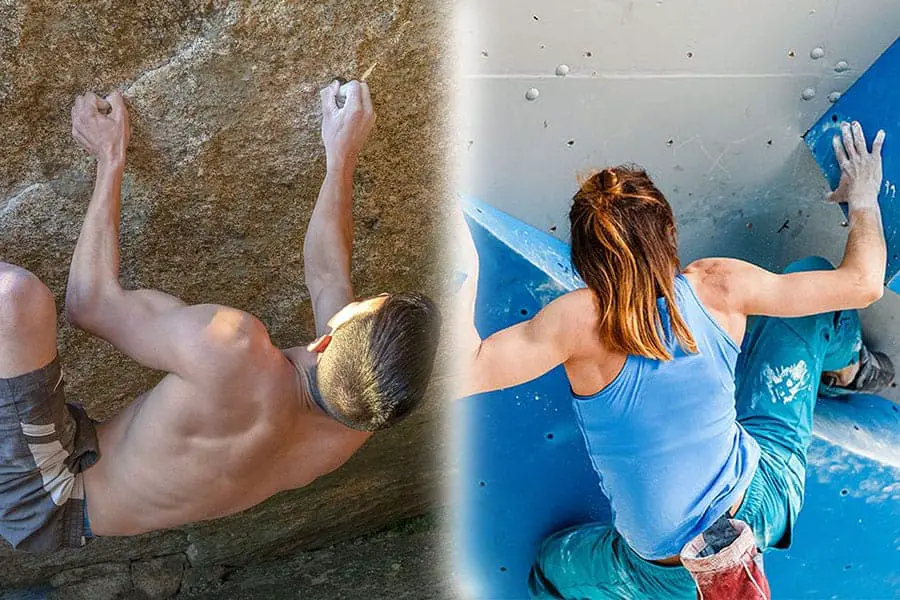Comparing indoor and outdoor bouldering is a common discussion among climbers. There is some controversy because some climbers prefer to look at climbing indoors and outdoors as a black and white grading conversion problem.
Other climbers, however, are more likely to compare the different challenges that relate to indoor and outdoor climbing while pointing out that the grading conversion problem is subjective and not relatable for the entire climbing community.
Overall, there are more mental and emotional challenges present in outdoor climbing, which can make outdoor climbing more difficult than indoor climbing routes for most climbers.
If you want to learn more about the mental and emotional challenges, in addition to a discussion about climbing grades and gyms that try to recreate outdoor routes, keep reading.
Fear of Falling
Climbing is an extremely mental challenge. Not only do you have to mentally figure out how to maneuver through the problem based on your personal strengths and weaknesses, but you also have to have the mental confidence to make the next move.
There are many mental hurdles that you need to overcome in order to climb your best and fear of falling is one of those huge hurdles.
According to Verticle Mind, a great book by Don McGrath and Jeff Elison for improving your mental game in climbing, the fear of falling is a leading reason that climbers associate with being unable to finish a climb.
When you have a fear of falling, you are more likely to over grip, which causes you to drain energy faster. In addition, you are more likely to psych yourself out and climb down instead of taking the risk to get to the next move.
The more you fear to fall, the harder/more challenging the climb will be.
Fear of falling seems to be more prevalent in outdoor climbing than it is in indoor climbing. This is likely because indoor climbing gyms have extensive padding and other safety precautions that make risk of injury lower, and thus the risk of falling is less and thus your fear of falling is likely less prevalent and easier to climb past.
On the other hand, climbing outdoors can be extremely stressful when it comes to the fear of falling. When bouldering outdoors, you have to rely on the 4-inch pad that you brought and you have to trust your climbing partner that may or may not be strong enough or prepared enough to push you onto the mat if needed.
All of these extra variables increase your chances of getting hurt, which increases risk, which increases the relativity of your fear of falling, creating an extremely difficult hurdle to climb past, which, in turn, makes it more challenging.
Climbing Handholds
Some climbers note that you won’t find jugs or specific handhold types out in the wild. True, you won’t find a purple handle protruding out of the rock face in the wild but you will likely find a handhold that you can place four fingers around and use just like you would a jug.
The same goes for every other kind of climbing hold. It doesn’t matter that the exact same shape isn’t in the wild, you will likely find the function of different handholds in the gym mimic the function of a handhold in the wild.
The biggest difference in the shape or function of handholds indoor vs handholds outdoors is that it will be harder to see and instead of protruding from the wall, it will likely be built into the wall.
The texture or rock type of those handholds, however, can make the climbing holds outdoors more challenging. Depending on where you are climbing, you may get lucky climbing on limestone or something like that and have a similar texture to the handholds in your gym but some rock types are slippery like sandstone or rough like granite.
This variation in the texture of handholds can make outdoor climbing more difficult. Especially if it adds to your fear of falling.
Clear Beta
When it comes to figuring out the route and what handholds and foothold you are supposed to use to reach the top, indoor bouldering is much easier. There is usually some sort of color-coding that shows you all of the options to put your hands and feet.
In comparison, outdoor climbing doesn’t have clear placement for your hands or feet. A lot of times there are no markings nor any indication of what kind of handholds are available to you. This makes it so you have to thoroughly review each crack or crevice that you can see and then at a certain height you just have to feel around for something that you can grab onto.
Unless there is a substantial amount of chalk throughout the entire climb or you watch someone else climb the route, you have to pretty much feel around for something.
The lack of clear beta makes it more common for people to have to project the climb until they figure out the route that works for them.
In the gym, you may only need to try three or four times to get up the climb. Outdoors, you will likely have to try it six or eight times, if not more, to figure out how to get up the climb.
Climbing Grades
Climbing grades aren’t scientific or data-driven. They are supposed to be based on the challenge that is presented for each move of a climb but how challenging a move is, is based on the individuals’ strengths and weaknesses, physically, mentally and emotionally that is grading it.
During my research about this topic, I found that most articles comparing indoor to outdoor bouldering difficulty focused on a tangible number, the grading system. For example, a V0 outdoors is equivalent to a V3 or V4 indoors.
That comparison, however, is simplistic and doesn’t take into account the individual’s perspective on how challenging the climb is. If you have to do the splits to reach this climbing hold and that makes it a V5, then a move in the climbing gym that makes you do the splits should also be a V5, right?
This is where it gets tricky and is no longer simplistic. In addition to the physical movement, you also have to consider the mental and emotional movement as well.
If a climber is afraid of heights or falling, then that move will likely be more difficult when they are outdoors compared to when they are indoors. For that individual climber, that move may be a V6 outdoors and a V5 indoors.
For another climber, they may not have a fear of falling or any other mental or emotional challenges related to that movement and for them, it would be a V5 outdoors and a V5 indoors.
So the question is, what challenges did the climber who actually published the grade for that climb feel. And does that match how you feel?
This brings me to my overall point about climbing grades.
The climbs you are working on are graded based on someone else’s feelings. Those feelings may or may not relate to how you feel about it and thus it may not be equivalent to how you feel about it or how you would grade it.
What About Gyms That Replicate Outdoor Routes?
Many rout-setters have tried to replicate a problem outdoors in their gym. You have probably also seen this in documentaries where climbers replicate the climb at the gym so they can practice it in the safety of their well-padded area that is also weatherproof before trying it outdoors the next season.
However, even when the route-setter does their best to replicate the outdoor route by measuring everything perfect and buying new volumes or climbing holds to mimic the shape of the rock face and climbing holds outdoors, very few expressed feeling like they actually accomplished replicating it.
A possible reason that they failed to replicate how the climb feels is that they aren’t able to replicate the additional mental or emotional challenges such as the fear of falling or the additional unclear beta.
That lack of emotional and mental challenges makes a climber “feel” like it is more difficult outdoors than it is indoors because there are fewer challenges indoors.
Conclusion
Some climbers will find that the grading system of a gym is similar to the grading system of an outdoor climb but other climbers will find that outdoor climbing is much more difficult than that of indoors.
Some climbers try to give a basis of how to convert outdoor grading levels to indoor grading levels but it isn’t that black and white.
Unfortunately, there isn’t a scientific or data-driven means to measure how challenging a climb may be because every climber has different strengths and weaknesses, whether that be physical, mental or emotional so the challenge level is different for different people.
More Trending Topics Like This:
- What Happened During The Men’s 2021 Climbing Olympics?
- Who Are The Climbers Competing In The Tokyo Olympics 2021?
- Is Climbing A Sport?
- How Many Calories Do You Burn From Climbing?
- 17 Reasons Why Bouldering Is So Popular
- The Evolution Of Climbing Belay Devices
- 23 Storage Ideas For Your Climbing Gear
- Why Is Climbing Such A Mental Sport?
- The Best Way To Take Climbing Chalk Through Airport Security
- Is Bouldering That Hard? Yea, It’s Hard – This Is Why
- Is Climbing Considered A Sport
- Is Climbing And Bouldering Good For Cardio?
- Top 10 Home Climbing Gym Designs
- 9 Signs You’re Seriously Addicted To Climbing
- Why Do People Like Climbing?
- What You Need To Know About Climbing In The 2021 Tokyo Olympics
- Can Climbing Build Abs And Make You Look Chiseled
- How To Introduce Your Friends To Climbing (15 Steps)
- Tips For Handling Your Period While Climbing
- Is Bouldering Outdoors Harder Than Indoors?
- Can You Go Rock Climbing Outdoors During The Covid 19 Pandemic?
- 7 Reasons To Wear Socks With Climbing Shoes
- What Is Dabbing? | Climbing Vocabulary And Culture
- Bouldering Vs Climbing: Training, Skills, Strength, Grades
- Indoor Vs Outdoor Climbing: A Thorough Comparision
- 22 Health Benefits Of Climbing – Backed By Research
- Bouldering And Sports Climbing Glossary: Lingo And Language
- Quick Tips For Getting Back Into Climbing After A Long Break
- 10 Legit Reasons You Should Not Rock Climb
- Can Climbing Build Muscle And Replace Weight Training?
- Do You Wear Socks With Rock Climbing Shoes?
- Is Bouldering Dangerous?
- What Should You Record In A Climbing Journal?
- How Are Climbing Routes Graded?
- First Time At The Bouldering Gym – What You Should Know
- 7 Common Mistakes In Rock Climbing For Beginners
- How Do Alpinists Get Down?


